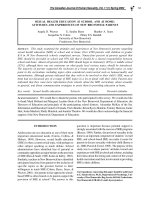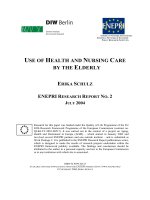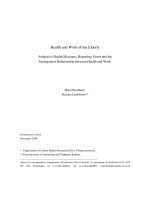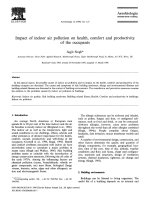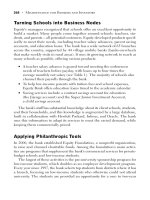American Red Cross Text-Book on Home Hygiene and Care of the Sick pptx
Bạn đang xem bản rút gọn của tài liệu. Xem và tải ngay bản đầy đủ của tài liệu tại đây (802.07 KB, 154 trang )
American Red Cross Text-Book on Home
by Jane A. Delano and Anne Hervey Strong and
American Red Cross
The Project Gutenberg EBook of American Red Cross Text-Book on Home
Hygiene and Care of the Sick, by Jane A. Delano and Anne Hervey Strong and American Red Cross This
eBook is for the use of anyone anywhere at no cost and with almost no restrictions whatsoever. You may copy
it, give it away or re-use it under the terms of the Project Gutenberg License included with this eBook or
online at www.gutenberg.net
Title: American Red Cross Text-Book on Home Hygiene and Care of the Sick
Author: Jane A. Delano Anne Hervey Strong American Red Cross
Release Date: May 4, 2010 [EBook #32250]
Language: English
Character set encoding: ISO-8859-1
American Red Cross Text-Book on Home by Jane A. Delano and Anne Hervey Strong and American Red Cross1
*** START OF THIS PROJECT GUTENBERG EBOOK AMERICAN RED CROSS TEXT-BOOK ***
Produced by Heiko Evermann, Fox in the Stars, S.D., and the Online Distributed Proofreading Team at
AMERICAN RED CROSS TEXT-BOOK
ON
HOME CARE OF THE SICK
***
DELANO
AMERICAN RED CROSS
TEXT-BOOK
ON
HOME HYGIENE
AND
CARE OF THE SICK
BY
JANE A. DELANO, R. N.
Chairman of the National Committee, Red Cross Nursing Service; Director, Department of Nursing,
American Red Cross; Late Superintendent of the Nurse Corps, U. S. A.; of the Training Schools for Nurses,
Bellevue Hospital, New York City; and of the Training School for Nurses, Hospital of the University of
Pennsylvania, Philadelphia
REVISED AND REWRITTEN
BY
ANNE HERVEY STRONG, R. N.
Professor of Public Health Nursing, Simmons College, Boston
This is the Second Edition of the American Red Cross Text-book in Elementary Hygiene and Home Care of
the Sick by Jane A. Delano and Isabel McIsaac.
PREPARED FOR AND ENDORSED BY
THE AMERICAN RED CROSS
PHILADELPHIA P. BLAKISTON'S SON & CO.
American Red Cross Text-Book on Home by Jane A. Delano and Anne Hervey Strong and American Red Cross2
1012 WALNUT STREET
COPYRIGHT, 1918, BY AMERICAN RED CROSS
THE MAPLE PRESS YORK PA
PREFACE
To the woman who wishes to protect her family from preventable diseases and is anxious to fit herself in the
absence of a trained nurse to give intelligent care to those who are sick, this revision of the Red Cross
text-book on Elementary Hygiene and Home Care of the Sick is particularly directed. It should appeal to men
and to women who are interested in maintaining the health of their neighborhoods and communities and in
affording effective coöperation to the public health authorities. To teachers wishing to impart protective health
information to high school pupils, the book also should be useful as a class text as well as a guide.
The war, which has caused the withdrawal from private practice of thousands of physicians and graduate
nurses, makes it peculiarly important to the nation for every adult to have sound knowledge as to how to
prevent contagion and epidemics, especially by precautionary attention to home and local sanitation. With
nurses becoming more difficult to secure, the safety of the family demands that some member in each
household know enough about elementary nursing to make a patient comfortable and to carry out accurately
the instructions of the physician.
The work of revision, based upon the latest knowledge of hygiene, sanitation and methods of home-nursing
has been done by Miss Anne Hervey Strong, Professor of Public Health Nursing, Simmons College, under the
personal direction of the author and the National Committee on Red Cross Nursing Service. The material has
been painstakingly read by Dr. H. W. Rucker and Dr. Taliaferro Clarke of the United States Public Health
Service, and Lieutenant Colonel Clarence H. Connor, Medical Corps, United States Army. Indebtedness to
Dr. H. M. McCracken, President of Vassar College and Director of the Red Cross Junior Membership, for his
valuable suggestion as to adapting the book for high school use as well as for the assistance rendered by his
Department, also is gladly acknowledged.
J. A. D.
ACKNOWLEDGMENT
I wish to express my gratitude to those who have so kindly helped in the work of preparing the present
edition. Thanks are especially due to Professor Isabel Stewart, Miss Anna C. Jamme, Professor Curtis M.
Hilliard, Professor Maurice Bigelow, Miss Katharine Lord, Miss Josephine Goldmark, and Miss Evelyn
Walker.
A. H. S.
CONTENTS
PREFACE v
INTRODUCTION xi
American Red Cross Text-Book on Home by Jane A. Delano and Anne Hervey Strong and American Red Cross3
CHAPTER I
PAGE
CAUSES AND PREVENTION OF SICKNESS 1
Communicable diseases, 1. Micro-organisms and bacteria, 1. Parasites, 3. Structure and development of
parasites, 4. Bacteria, 4. Shape, 4. Size, 5. Motion, 5. Multiplication, 5. Spores, 7. Distribution, 8. Protozoa, 8.
Visible parasites, 8. Transmission of pathogenic organisms, 9. Defenses of the body, 12. Immunity, 13.
Vaccination and inoculation, 15. Carriers, 17. Non-communicable diseases, 20. Physical examinations, 22.
CHAPTER I 4
CHAPTER II
HEALTH AND THE HOME 27
Heredity, 27. Hygiene of environment and person, 28. Ventilation, 29. Lighting, 32. Cleanliness of houses, 33.
Garbage, 37. Insects, 38. Sewage, 39. Personal cleanliness, 41. Oral hygiene, 44. Treatment of teeth, 46.
Clothing, 47. Food, 48. Elimination, 52. Rest and fatigue, 53. Sleep, 55. Recreation, 55.
CHAPTER II 5
CHAPTER III
BABIES AND THEIR CARE 60
Growth and development, 64. Average size, 64. Muscular development, 65. Development of special senses, of
speech, of teeth, 66. Normal excretions, 67. Clothing, 68. Sleep, 70. Fresh air, 72. Diet, 72. Intervals of
feeding, 73. Water, 75. Weaning, 75. Nursing bottles and nipples, 75. Tables of diet, 78. Bathing, 78. Eyes,
80. Mouth, 81. Nostrils, 81. Genital organs, 81. Development of habits, 82. Exercise, 83. Play and toys, 85.
CHAPTER III 6
CHAPTER IV
INDICATIONS OF SICKNESS 88
Objective symptoms, 92. Temperature, 92. Pulse, 96. Respiration, 99. General appearance, 100. Special
senses, 101. Voice, tongue, throat, gums, 102. Cough, 103. Appetite, 103. Excretions, 103. Loss of weight,
104. Sleep, 104. Mental conditions, 104. Subjective symptoms, 105. Pain, 105. Records, 107. Tuberculosis,
cancer and mental illness, 107. Tuberculosis, 109. Cancer, 111. Mental illness, 112.
CHAPTER IV 7
CHAPTER V
EQUIPMENT AND CARE OF THE SICK ROOM 117
Choice of a sick room, 118. Furnishing, 120. Ventilation, 123. Heating, 124. Lighting, 124. Cleaning, 126.
The attendant, 127.
CHAPTER V 8
CHAPTER VI
BEDS AND BEDMAKING 132
Bedsteads, 133. Mattresses, 135. Care of the mattress, 136. Pillows, 136. Protection of the mattress and
pillows, 137. Rubber sheets and pillow-cases, 138. Sheets, 139. Draw sheets, 139. Pillow covers, 140.
Blankets, 140. Comforters and quilts, 141. Counterpanes, 141. Bedmaking, 141. To make an unoccupied bed,
143. To change a patient's pillows, 146. Lifting a patient in bed, 146. To turn a patient in bed, 147. To change
sheets while patient is in bed, 147. To move patient from one bed to another, 150.
CHAPTER VI 9
CHAPTER VII
BATHS AND BATHING 154
Cleansing baths, 154. Bed bath, 156. Care of the mouth and teeth, 160. Care of the hair, 163. To wash the hair
of a bed patient, 164. Hot foot-baths, 165. Cool sponge bath, 166.
CHAPTER VII 10
CHAPTER VIII
APPLIANCES AND METHODS FOR THE SICK-ROOM 169
Devices to give support, 172. Bedpans, 176. Daily routine in the sick-room, 179. Time for visitors, 182.
CHAPTER VIII 11
CHAPTER IX
FEEDING THE SICK 187
The digestive process, 188. Feeding the sick, 191. Liquid diet, 192. Semi-solid diet, 192. Light or
convalescent diet, 193. Full diet, 193. Serving food for the sick, 195. To feed a helpless patient, 197.
CHAPTER IX 12
CHAPTER X
MEDICINES AND OTHER REMEDIES 200
Action of drugs, 200. Amateur dosing, 202. Patent remedies, 205. Administration of medicine, 206.
Suppositories, 209. Enemata, 210. Sprays and gargles, 213. Inhalation, 213. Inunction, 214. Household
medicine cupboard, 215.
CHAPTER X 13
CHAPTER XI
APPLICATION OF HEAT, COLD AND COUNTER-IRRITANTS 220
Inflammation, 220. Hot applications, 225. Dry heat, 225. Moist heat, 227. Stupes or hot fomentations, 229.
Cold applications, 231. Dry cold, 231. Moist cold, 232. Cold compresses for the eyes, 232. Counter-irritants,
233. Mustard paste, 233. Mustard leaves, 234.
CHAPTER XI 14
CHAPTER XII
CARE OF PATIENTS WITH COMMUNICABLE DISEASES 236
Incubation period, 238. Care of patients with colds or other slight infections, 238. Care during more serious
infections, 242. Children's diseases, 246. Rules for isolation and exclusion from school, 247. Disinfection,
248. Care of nose and throat discharges, 249. Care of discharges from the bowels and bladder, 249. Bath
water, 250. Care of the hands, 250. Care of utensils, 251. Care of linen, 251. Disinfection of the person, 252.
Termination of quarantine, 252. Terminal disinfection, 253. Fumigation, 254.
CHAPTER XII 15
CHAPTER XIII
COMMON AILMENTS AND EMERGENCIES 257
Conditions in which the nervous system is involved, 257. Headache, 257. Sleeplessness, 258. Fainting, 259.
Convulsions, 260. Shock, 261. Stimulants, 263. Sunstroke and heat exhaustion, 264. Conditions in which the
digestive tract is affected, 265. Nausea and vomiting, 265. Hiccough, 265. Diarrhoea, 266. Constipation, 266.
Colic, 266. Conditions in which the eyes or ears are affected, 267. Styes, 267. Foreign bodies in the eye, 267.
Disorders affecting the ears, 268. Conditions in which the skin is affected, 269. Prickly heat, 269. Insect bites
and stings, 270. Ivy poisoning, 270. Other emergencies, 270. Chills, 270. Croup, 271. Bleeding, 272.
Treatment of slight wounds, 272. Nose bleed, 274. Profuse menstruation, 275. Other injuries, 275. Sprains,
275. Bruises, 276. Burns and scalds, 277. Brush burn, 278.
CHAPTER XIII 16
CHAPTER XIV
SPECIAL POINTS IN THE CARE OF CHILDREN, CONVALESCENTS, CHRONICS, AND THE AGED
280
Children, 281. Physical defects, 283. Eye-strain, 284. Enlarged tonsils and adenoids, 284. Defective hearing,
285. Defective teeth, 286. Posture, 286. Predisposition to nervousness, 292. Convalescent patients, 294.
Chronic patients, 299. Care of the aged, 303.
CHAPTER XIV 17
CHAPTER XV
QUESTIONS FOR REVIEW 312
APPENDIX 319
Circulars of information issued by Division of Child Hygiene, New York Department of Health.
GLOSSARY 326
INDEX 331
INTRODUCTION
Health and sickness, at all times momentous factors in the welfare of our nation, now as never before are
matters of vital importance. To win its victories both in peace and in war, the nation needs all its citizens with
all their powers, and it is a matter of more than passing interest that, as conservative estimates show, at least
three persons out of every hundred living in the United States are constantly incapacitated by serious sickness.
In 1910 these seriously sick persons numbered more than 3,000,000. Even more significant, perhaps, is the
fact that at least half of our national sickness could be prevented if knowledge and resources that we now
possess were fully utilized.
The problem of sickness is by no means peculiar to our own day and generation. It has been a medical, a
religious, and a social problem in every age. From the time of Job its meaning has baffled philosophers; from
his day to ours thoughtful men have devoted their lives to searching for causes and cures. Yet before the
middle of the last century little progress was made, either in scientific treatment or in prevention of disease.
The invention of the microscope first made possible a real understanding of sickness. Through the microscope
a new world was revealed, a world of the infinitely small, swarming with tiny forms of animal and vegetable
life. No one, however, appreciated the significance of these hitherto invisible plants and animals until the
latter part of the 19th century, when the great French savant, Pasteur, proved that little vegetable forms, now
called bacteria, cause putrefaction and fermentation, and also certain diseases of animals and man. Pasteur's
discoveries were carried still further by other scientists, with the result that bacteriology has revolutionized
medicine, agriculture, and many industries, and has made possible the brilliant achievements of modern
sanitary science. For the first time in history the prevention of epidemics has become possible, and sickness is
no longer regarded as a punishment for sin.
Actual care of the sick, both in homes and in hospitals, has always been one of the responsibilities of women.
The first general public hospital was built in Rome in the 4th century after Christ by Fabiola, a patrician lady.
There she nursed the sick with her own hands, and from her day to ours extends an unbroken line of devoted
women, handing down through the centuries their tradition of compassionate nursing service. It remained for
Florence Nightingale, however, to give to the training its technical and scientific foundation, and thus to found
the profession of nursing. As a result of her work, effectiveness was added to the spirit of service, that spirit
which inspires the modern nurse no less than in an earlier day it inspired the Sisters of Charity who died
nursing the wounded on the battlefields of Poland.
But different generations have different needs, and to meet them the spirit of service must manifest itself in
widely varying ways. The sick need care today no less than they did when St. Elizabeth bathed the feet of the
lepers; but such limited service, however beautiful, is no longer enough. Today we serve best by preventing
sickness. Cure of sickness and alleviation of suffering must never be neglected; not in cure, however, but in
prevention lies the hope of modern sanitary science, of modern medicine, and of modern nursing.
CHAPTER XV 18
Nearly every woman at some time in her life is called upon to assist in caring for the sick. Indeed,
approximately 90% of all sick persons in the United States are cared for at home, even in cities where hospital
facilities are good. Moreover, every woman is largely responsible for maintaining her own health, and few
escape responsibility at some time for maintaining the health of others. For such responsibility most women
are poorly prepared. Every year in our own country thousands of persons, many of them babies and children,
die merely because someone, in many cases a woman, is fatally ignorant of the laws governing sickness and
health.
Only prolonged and careful training, such as good hospital training-schools afford, can furnish the skill and
judgment required in nursing persons who are seriously ill. Upon the trained nurse the modern practice of
medicine makes great and ever-increasing demands: a nurse must perform complicated duties, meet critical
situations, and carry out a wide variety of measures based on scientific principles which she must understand.
Good will and sympathy are no longer enough; amateur nursing, even when performed with the best
intentions, may involve grave dangers for those who are seriously ill.
On the other hand, although it is true that a little knowledge is a dangerous thing, it is no less true that total
ignorance may be more dangerous still. For instance, in cases of incipient, slight, or chronic illness, and in
certain emergencies a little knowledge may be safer far than no knowledge at all; and no one, surely, should
be ignorant of the principles of hygiene.
The American Red Cross, recognizing the part that women can and should play in preventing sickness and in
building up the health and vigor of the nation, has added to its larger patriotic services this elementary course
of instruction in hygiene and home care of the sick. The lessons are not intended to take the place of a nurse's
training, and procedures requiring technical skill are necessarily omitted. The object of the book is to supply a
little knowledge of sickness, which though limited may yet be safe. The book is also designed to set forth
some general laws of health; to make possible earlier recognition of symptoms; to teach greater care in
guarding against communicable disease; and to describe some elementary methods of caring for the sick,
which, however simple, are essential to comfort, and sometimes indeed to ultimate recovery.
FOR FURTHER READING
A History of Nursing Dock and Nutting, Volume I.
The Life of Florence Nightingale Cook.
The Life of Pasteur Vallery-Radot.
The House on Henry Street Wald.
Public Health Nursing Gardner, Part I, Chapters I-III.
Origin and Growth of the Healing Art Berdoe.
Medical History from the Earliest Times Withington.
Under the Red Cross Flag Boardman.
Report on National Vitality Fisher, (Bulletin 30 of the Committee of One Hundred on National Health.
Government Printing Office, Washington).
CHAPTER XV 19
CHAPTER I
CAUSES AND PREVENTION OF SICKNESS
Diseases of two kinds have long been recognized: first, those transmitted directly or indirectly from person to
person, like smallpox, measles, and typhoid fever; and second, diseases like heart disease and apoplexy, which
are not so transmitted. These two classes are popularly called "catching" and "not catching;" the former are
the infectious or communicable diseases, and the latter the non-infectious or non-communicable. The term
contagious, formerly applied to diseases supposed to be spread only by direct contact, is no longer an accurate
or useful term.
THE COMMUNICABLE DISEASES
The invention of the microscope, as we have seen, revealed the existence of innumerable little plants and
animals, so small that even many millions crowded together are invisible to the naked eye. These tiny living
creatures are called micro-organisms or germs. The plant forms are called bacteria (singular, bacterium), and
the animal forms protozoa (singular, protozoön). The common belief that all or even most bacteria are harmful
is quite unfounded. As a matter of fact, while not less than 1500 different kinds of micro-organisms or germs
are known, only about 75 varieties are known to produce disease.
Most bacteria belong to the class of micro-organisms called saprophytes, which find their food in dead
organic matter, both animal and vegetable, and cannot flourish in living tissues. These saprophytes act upon
the tissues of dead animals and vegetables, and resolve them into simpler substances, which are then ready to
serve as nourishment for plants higher in the vegetable kingdom. Thus the processes which we know as
fermentation and putrefaction are due to the action of saprophytes. Higher plants in turn furnish food for men
and animals, and so the food supply is used over and over in different forms, making what is known as the
food cycle. If it were not for bacterial activities vegetation would be robbed of its supply of nourishment, and
plant life would speedily end; destruction of plant life would deprive the animal kingdom of food and thus all
life would become extinct. The saprophytes are consequently essential to the existence of both animals and
vegetables.
There are, however, other organisms called parasites, which can exist in living tissues of animals or
vegetables. The organisms at whose expense the parasites live are called their hosts. Parasites not only
contribute nothing to their hosts, but generally harm them by producing poisonous substances or depriving
them of food. Some parasites are able to lead a saprophytic existence also, but as a rule they live at the
expense of animal or plant life. Pathogenic, or disease-producing, germs belong to the group of parasites. The
pathogenic germs which find favorable soil in the body produce poisons called toxins. These poisons or toxins
interfere with the bodily functions, and thus cause what we know as communicable disease. Communicable
diseases are caused by specific germs only: that is, a certain disease cannot develop unless its particular germs
are present; the germs of typhoid for instance, can cause typhoid fever only, and not tuberculosis or other
disease.
A number of diseases are caused by micro-organisms that are now well known. Chief among these diseases
are colds, septicæmia (blood poisoning), influenza, pneumonia, diphtheria, typhoid fever, tuberculosis,
whooping cough, Asiatic cholera, bubonic plague, meningitis, tetanus ("lock jaw"), leprosy, gonorrhoea,
syphilis, relapsing fever, typhus fever, glanders, and anthrax. Micro-organisms not yet identified probably
cause the communicable diseases whose origin is not known with certainty. These include infantile paralysis,
smallpox, scarlet fever, measles, mumps, chicken-pox, Rocky Mountain spotted fever, yellow fever,
hydrophobia (rabies), foot-and-mouth disease. We can hardly doubt that the intensive laboratory research now
in progress will reveal in the near future the specific germs of these diseases also.
STRUCTURE AND DEVELOPMENT OF PARASITES
CHAPTER I 20
The group of parasites consists of two general classes, the vegetable, and the animal. In the former class
belong the bacteria, and in the latter the protozoa. The two classes are not sharply differentiated, but in general
the vegetable parasites are less highly organized than the animal.
BACTERIA
SHAPE Bacteria are composed of single cells and are consequently called unicellular organisms. Under the
microscope individual cells are seen to differ in size, shape, and structure. In shape bacteria show three
different types; the rod-shaped (bacillus), the spherical (coccus), and the spiral (spirillum). The organisms
causing typhoid fever for example are a variety of bacilli, those causing pneumonia are cocci, while those
causing Asiatic cholera are spirilla.
[Illustration: FIG. 1 BACILLI OF VARIOUS FORMS. (Williams.)]
SIZE Bacteria vary greatly in size. Average rod-shaped bacteria are about 1/25000 of an inch long, but there
are undoubtedly organisms so small that they cannot be seen, even by means of the strongest microscopes we
now possess.
[Illustration: STAPHYLOCOCCI. STREPTOCOCCI. DIPLOCOCCI. TETRADS. SARCINÆ. FIG.
2 (Williams.)]
MOTION The power of motion in certain species of bacteria is due to hair-like appendages called flagella.
These flagella by a lashing movement somewhat resembling the action of oars enable the organisms to move
through fluids.
MULTIPLICATION After bacteria have fully developed, each cell divides into two equal parts; the process
of division is called fission. Each of these two parts rapidly grows into a full-sized organism. Then fission
again takes place, so that four bacteria replace the original one. In each of the four, fission occurs again, and
so the process of multiplication continues. As bacteria develop they group themselves in characteristic ways.
Some, like the streptococci, arrange themselves in chains; the diplococci, in pairs; the tetrads, in groups of
four; others in packets called sarcinæ, and still others, the staphylococci, form masses supposed to resemble
bunches of grapes.
[Illustration: FIG. 3 SPIRILLA OF VARIOUS FORMS. (Williams.)]
[Illustration: FIG. 4 BACTERIA SHOWING FLAGELLA. (Williams.)]
Under favorable conditions fission occurs rapidly; in some types a new generation may appear as often as
every 15 minutes. Enormous multiplication would result if nothing occurred to check the process. But in
nature such increase never continues unhindered, and bacteria, acting upon their food substances, produce
acids and other materials injurious to themselves. Furthermore, lack of proper food, moisture, or favorable
temperature, and competition with other organisms tend to prevent their unrestricted growth and
multiplication.
[Illustration: FIG. 5 BACTERIA WITH SPORES. (Williams.)]
SPORES Most bacteria die if conditions become unfavorable to their growth, but some enter into a resting
stage. This stage is characterized by the development of round or oval glistening bodies called spores, which
are of dense structure and possess an extraordinary power to withstand heat, chemicals, and unfavorable
surroundings. Except in rare instances a single cell produces but one spore. As soon as favorable conditions of
temperature, moisture, and food supply are restored, the spore develops into the active form of the germ; it
may, however, remain dormant for months or years. Spore formation, however, occurs in only a very few
CHAPTER I 21
varieties of pathogenic bacteria.
DISTRIBUTION Bacteria are very widely distributed in nature; they are in fact found practically
everywhere on the surface of the earth. They are present in plants and water and food; on fabrics and
furniture, walls and floors; and they are found in great numbers on the skin, hair, many mucous surfaces, and
other tissues of the body.
PROTOZOA
The protozoa are the lowest group of the animal kingdom. Like bacteria they are composed of single cells so
small as to be visible only under the microscope. They play an important part in causing certain diseases of
man, especially in the tropics. Among the well-known human diseases of protozoan origin are malaria,
amoebic dysentery, and sleeping-sickness. Protozoa also cause several wide-spread and serious plagues of
domestic animals.
VISIBLE PARASITES
A few diseases are caused by parasites large enough to be seen with the naked eye. One of the most important
is hookworm disease. This disease is caused by a tiny worm which penetrates the victim's skin and ultimately
finds its way into the intestine. Other diseases also are caused by parasitic worms, such as tapeworms,
pinworms, and trichinæ. The latter are acquired as a result of eating infected meat, particularly infected pork
that has not been thoroughly cooked.
TRANSMISSION OF PATHOGENIC ORGANISMS
Pathogenic or disease producing organisms need for their development food, moisture, darkness, and warmth,
conditions that exist within the human body. When one or more of these factors is unfavorable, development
of germs is checked; if unfavorable conditions are extreme or long continued, the organisms begin to die. It is
difficult to say at exactly what moment they will die if deprived of moisture or exposed to extremes of
temperature or other unfavorable conditions, just as it would be impossible to state at exactly what moment a
collection of house plants would all be dead if water were withheld, or if the room temperature were greatly
reduced.
Most pathogenic organisms, however, do not flourish long outside the body, and owe their continued
existence to a fairly direct transfer from person to person. They gain access to the body through mucous
surfaces such as the respiratory and digestive tracts, and through breaks in the skin, such as cuts, abrasions,
and the bites of certain insects. They leave the body chiefly in the nasal and mouth discharges, as in coughing,
sneezing, and spitting, in the urine and bowel discharges, and in pus or "matter."
[Illustration: FIG. 6. (L. H. Wilder.)]
The problem of controlling communicable diseases, consequently, lies in preventing the bodily discharges of
one person from travelling directly into the body of another. If a person is not expelling pathogenic germs, it
is clear that he cannot pass diseases on to others. But both pathogenic and harmless germs follow the same
routes from person to person, so that safety as well as decency lies in preventing so far as possible all
exchanges of bodily discharges.
There are five routes by which the bodily discharges most frequently travel from one person to another. Four
of these routes of infection are called public, because in most cases efforts of individuals alone are not
sufficient to control them. The public routes are water, milk, food, and insects. The fifth, or private route,
includes all means by which fresh discharges of one person are passed to another, as when nose and mouth
discharges are carried in coughing, sneezing, and kissing, or when bowel and bladder discharges are carried
CHAPTER I 22
by the hands. These five routes in a given case differ greatly in relative importance, but the fifth, or direct
route plays an immense part, although its importance in causing sickness has only lately been recognized. It
cannot be too strongly emphasized that the chief agent in the spread of human diseases is man himself, and the
human hand is the great carrier of disease germs both to and from the body. If unclean hands could be kept
away from the orifices of the body, particularly the mouth, many diseases would soon cease to exist.
Defenses of the Body
In view of all the dangers from disease-producing germs it may seem surprising that the human race has not
long ago succumbed to its invisible enemies. But the body has various defenses by means of which it may
prevent invasion, or successfully combat its enemies in case they do gain access.
The unbroken skin is usually impassable to bacteria. Virulent organisms are often found upon the skin of
perfectly healthy persons, where they appear to be harmless unless an abrasion occurs which affords entrance
into the deeper tissues. Most bacteria breathed in with the air cling to the moist surfaces of the air-passages
and never reach the lungs.
Mucous membranes lining the mouth and other cavities of the body would prove favorable sites for the
growth of bacteria if the mucus secreted by them were not frequently removed. The mouth of a healthy person
may contain bacteria of many kinds, but the saliva has a slight disinfectant power and serves as a constant
wash to the membranes. The normal gastric (stomach) juice is decidedly unfavorable to the growth of
bacteria, although it does not always kill them; they often pass through the stomach and are found in large
numbers in the intestines. Other bodily secretions, such as the tears and perspiration, tend to discourage
bacterial growth.
Tissues of the body vary greatly in their power to resist invading germs, so that the route by which germs
enter influences the severity of their effects. Typhoid bacilli and the spirilla of Asiatic cholera when taken
with food or water produce far more serious disturbances than when injected under the skin; infections from
pus germs through an abrasion of the skin may result in a slight local disturbance, while the same amount
introduced into a deeper wound might cause a fatal infection. Certain germs nourish in certain tissues only;
even tuberculosis, which attacks practically all tissues, has its favorite locations.
IMMUNITY In addition to its mechanical defenses against disease, the body shows a varying degree of
immunity, or the power possessed by living organisms to resist infections. Immunity or resistance is the
opposite of susceptibility. It is exceedingly variable, being greater or less in different people and under
different conditions, but the exact ways in which it is brought about are still in many cases far from clear.
Immunity may be natural or acquired. By natural immunity is meant an inherited characteristic by which all
individuals of a species are immune to a certain disease. The natural immunity of certain species of animals to
the diseases of other animals is well known. Man is immune to many diseases of lower animals, and they in
turn are immune to many diseases of man. Cattle, for instance, are immune to typhoid and yellow fever, while
man shows high resistance to rinderpest and Texas fever; both, however, are susceptible to tuberculosis, to
which goats are immune. There are all gradations of immunity within the same species. Moreover, certain
individuals have a personal immunity against diseases to which others of the same race or species are
susceptible.
Immunity may be acquired in several ways. It is commonly known that one attack of certain communicable
diseases renders the individual immune for a varying length of time, and sometimes for life. Among these
diseases are smallpox, measles, whooping-cough, scarlet fever, infantile paralysis, typhoid fever, chicken-pox,
and mumps; erysipelas and pneumonia on the other hand appear to diminish resistance and to leave a person
more susceptible to later attacks.
CHAPTER I 23
Again, in some cases immunity may be artificially acquired by introducing certain substances into the body to
increase its resistance. Examples of this method include the use of antitoxin as a protection against diphtheria,
of sera in pneumonia and other infections, and vaccination against smallpox and typhoid fever whereby a
slight form of the disease is artificially induced. Laboratory research goes on constantly, and doubtless many
more substances will eventually be discovered that will reduce human misery as vaccines and antitoxin have
already reduced it.
Vaccination and inoculation have saved thousands of lives. Smallpox, once more prevalent than measles, was
the scourge of Europe until vaccination was introduced. During the 18th century it was estimated that
60,000,000 people died of it, and at the beginning of the 19th century one-fifth of all children born died of
smallpox before they were 10 years old. In countries where vaccination is not practised the disease is as
serious as ever; in Russia during the five years from 1893-97, 275,502 persons died of smallpox, while in
Germany where vaccination is compulsory, only 8 people died of it during the year 1897. Death rates from
diphtheria and typhoid fever have been greatly reduced by the use of antitoxin and antityphoid vaccine. Thus
in New York State in 1894, before antitoxin was generally used, 99 out of every 100,000 of the population
died of diphtheria, while only 20 out of 100,000 died of it in 1914. In 1911 a United States Army Division of
more than 12,000 men camped at San Antonio, Texas, for four months. All of these men were vaccinated
against typhoid fever and only a single case occurred during the summer, although conditions of camp life
always tend to spread the disease.
While many and various factors tend to lower resistance rather than to increase it, the idea that these factors
act equally in all kinds of infection is erroneous.
"The principal causes which diminish resistance to infection are: wet and cold, fatigue, insufficient or
unsuitable food, vitiated atmosphere, insufficient sleep and rest, worry, and excesses of all kinds. The
mechanism by which these varying conditions lower our immunity must receive our attention, for they are of
the greatest importance in preventive medicine. It is a matter of common observation that exposure to wet and
cold or sudden changes of temperature, overwork, worry, stale air, poor food, etc., make us more liable to
contract certain diseases. The tuberculosis propaganda that has been spread broadcast with such energy and
good effect has taught the value of fresh air and sunshine, good food, and rest in increasing our resistance to
this infection.
"There is, however, a wrong impression abroad that because a lowering of the general vitality favors certain
diseases, such as tuberculosis, common colds, pneumonia, septic and other infections, it plays a similar rôle in
all communicable diseases. Many infections, such as smallpox, measles, yellow fever, tetanus,
whooping-cough, typhoid fever, cholera, plague, scarlet fever, and other diseases, have no particular relation
whatever to bodily vigor. These diseases often strike down the young and vigorous in the prime of life. The
most robust will succumb quickly to tuberculosis if he receives a sufficient dose of the virulent
micro-organisms. A good physical condition does not always temper the virulence of the disease; on the
contrary, many infections run a particularly severe course in strong and healthy subjects, and, contrariwise,
may be mild and benign in the feeble. Physical weakness, therefore, is not necessarily synonymous with
increased susceptibility to all infections, although true for some of them. In other words, 'general debility'
lowers resistance in a specific, rather than in a general, sense." (Rosenau: Preventive Medicine and Hygiene,
pp. 403 and 404.)
CARRIERS
Well persons who carry in their bodies pathogenic germs but who themselves have no symptoms of disease
are called carriers. Thus typhoid carriers have typhoid bacilli in the intestinal tract, while they themselves
show no symptoms of typhoid fever; diphtheria carriers have bacilli of diphtheria in the throat or nose, but
have themselves no symptoms of diphtheria, and so on. It has now been proved that many patients harbor
bacteria for weeks, months, or even years following an infection, and are dangerous distributors of disease;
CHAPTER I 24
also, some healthy individuals without a history of illness harbor living bacteria which may infect susceptible
persons in the usual ways. Transmission by healthy carriers goes far to explain the occurrence of diseases
among persons who have apparently not been exposed. This explanation has greatly clarified the whole
problem of the spread of communicable diseases. Carriers, unfortunately, exist in large numbers, and render
the ultimate control of disease exceedingly difficult. They can usually be identified by bacteriological tests.
To some extent they can be supervised; food handlers at least should be legally obliged to submit to physical
examinations, and should be licensed only when proved free from communicable disease.
Diseases are also spread by persons suffering from them in a form so mild or so unusual that they pass
unrecognized. These persons are known as "missed" cases. Carriers of disease and "missed" cases go freely
about the community, handling food, using common drinking cups, travelling in crowded street cars, standing
in crowded shops; in various ways coming into close contact with other people, coughing and sneezing and
kissing their friends no less often than normal individuals. It is consequently clear that the bodily discharges
of supposedly normal persons may be hardly less a menace than those of persons known to be infected.
Diseases that depend for transmission upon milk, water, food, and insects may be controlled by public action,
that is, by specific measures taken by a large group of people in order to protect the individual. Such action
constitutes public sanitation. There is, however, a large group of diseases, chiefly sputum-borne, that cannot
be controlled except by individual action. Such individual action constitutes a large part of personal hygiene.
The whole problem of controlling infections sounds simple, depending as it does for the most part upon
unpolluted water, milk, and food, extermination of certain insects, and cleanliness in personal behaviour. In
practice the problem is not so easy. Public sanitation has performed miracles in the past, and will do much in
the future; behaviour, however, will continue to be influenced by many factors, social and economic as well as
personal. Ignorance of the laws of health is an obstacle to progress, but in modern conditions even the
instructed may be unable to control their ways of living and working. Indeed, such control is at present limited
to the privileged few. On the ignorant and the poor, those least able to bear it, society loads the heaviest
burden of sickness. Only when ignorance and poverty are abolished, as one day they will be, can the final
stage be reached in the fight for public health.
THE NON-COMMUNICABLE DISEASES
In this group is included a great variety of maladies. Of some the causes are known, while in the case of
others, origin, prevention, and remedy are still obscure. Here belong defects in structure of the body, both
hereditary and acquired; insanity and other nervous diseases; new growths, like tumors and cancer;
disturbances of bodily processes, as malnutrition and gout; and the important class of degenerative diseases,
like arteriosclerosis, in which tissues become hardened and fibrous and hence less able to perform their
normal functions.
The degenerative diseases are playing a menacing part in national health. The average length of life in the
United States has shown a marked increase it is true, during the last 40 years. But this gain represents chiefly
the saving of life through prevention of communicable diseases, especially among babies and children; among
people who have passed the 30th year on the other hand, death rates are actually increasing. This increase is
most marked after the age of 45, and is caused chiefly by the increase of cancer, and of degenerative diseases
of the heart, blood vessels, and kidneys. Degeneration of tissues is normally a condition typical of old age, and
in aged persons it may occur in any tissue. There is no elixir of youth, and for old age there is no cure. But the
important facts in this connection are that degenerative changes now occur prematurely, and that among a vast
number of people, in various classes of society and various occupations, the vital organs show a marked
tendency to break down after the age of 45.
This condition is not inevitable. Before the beginning of the present war, death rates at all ages were
decreasing in England, Sweden, and other European countries. In America also degenerative diseases can be
CHAPTER I 25
